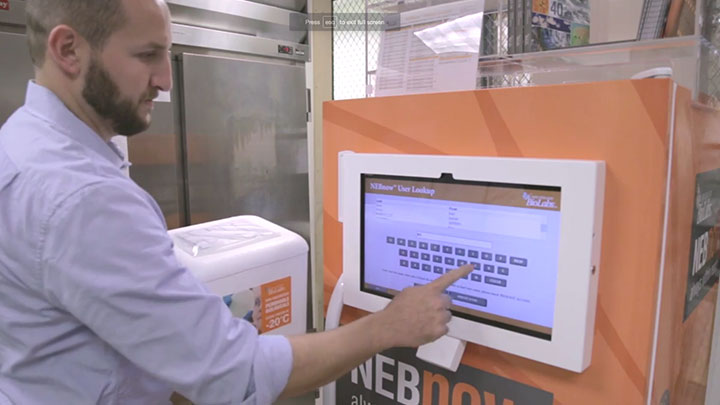Cappable-seq for prokaryotic transcription start site (TSS) determination
Cappable-seq is a method for directly enriching the 5’ end of primary transcripts developed at NEB. This is achieved by capping the 5’ triphosphorylated end of the RNA with the Vaccinia Capping System (NEB #M2080) and 3’-Desthiobiotin-GTP (NEB #N0761). The primary transcripts are enriched by binding to Hydrophilic Streptavidin Magnetic Beads (NEB #S1421) followed by washing and eluting with biotin. This method enables determination of transcription start sites at single base resolution (1).
Protocol:
Desthiobiotin-GTP (DTB-GTB) capping of prokaryotic RNA:
1. Prepare total RNA from prokaryotic source at a concentration of 300 ng/µl in water or 1.0 mM Tris pH 7.5, 0.1 mM EDTA.
2. Prepare the capping reaction as follows:
Component |
Reaction |
|
RNA |
10 μl |
|
10X VCE Buffer |
5 μl |
|
ddH20 |
25 μl |
|
Total |
40 μl |
3. Incubate reaction for 2 minutes at 70°C.
4. Place the reaction on ice.
5. Add the following to above reaction:
Component |
Reaction |
|
5 mM 3'DTB-GTP |
5 μl |
|
Vaccinia Capping Enzyme (10 units/µl) |
5 μl |
|
Total |
50 μl |
6. Incubate the reaction at 37°C for 30 minutes. Immediately proceed to cleanup.
Note: We have recently found that capping with DTB-GTP is more efficient in the absence of S-Adenosylmethionine (SAM).
RNA cleanup:
1. Purify RNA on a Zymo Research Clean and Concentrator™-5 column using manufacturer instructions for > 200 nucleotide RNA; with a total of 4 washes with RNA wash buffer.
Note: Wash the sides of the column that may have come into contact with the capping reaction, reducing the carryover of DTB-GTP.
2. Elute the RNA in 100 µl of 1 mM Tris pH 7.5, 0.1 mM EDTA (low TE).
Note: It is essential to completely remove unincorporated DTB-GTP (less than 0.01% DTB-GTP remaining). Alternative methods of RNA cleanup such as AMPure beads can also be employed. If the RNA is going to be directly bound to streptavidin before the following fragmentation step, an additional cleanup step should first be employed.
Enrichment of RNA:
1. Fragment desthiobiotin-GTP capped RNA by setting up the following reaction:
Component |
Reaction |
|
10X Polynucleotide Kinase Buffer |
2.5 µl |
|
Capped RNA |
100 µl |
|
Total |
102.5 µl |
2. Incubate for 5 minutes at 94°C. Put on ice.
3. Clean up RNA as follows:
A) Bind RNA to AMPure XP beads:
Add 1.8 volumes of AMPure beads to the eluted RNA volume and add 1.5 volumes of 100% ethanol to the resulting volume of the AMPure/RNA mix (i.e., if volume of RNA is 100 µl, add 180 µl of AMPure beads and 420 µl of ethanol). Incubate the beads on the bench for 5 minutes, then expose to a magnet and wash beads 2 times with 80% ethanol while confined with the magnet. Remove the tube from the magnet and elute the RNA in 75 µl of low TE.
B) Remove 3' phosphates from fragmented RNA:
To 75 µl of the eluted RNA add the following:
Component |
Reaction |
|
10X T4 polynucleotide Buffer |
8.8 µl |
|
ATP-free T4 Polynucleotide Kinase |
4 µl |
|
Total |
87.8 µl |
Incubate the reaction at 37°C for 15 minutes. Directly proceed to Streptavidin enrichment.
C) 1st round of streptavidin enrichment:
Hydrophilic streptavidin magnetic beads (NEB #S1421S) are prepared by washing 2 times with 400 µl of 10 mM Tris-HCl pH 7.5, 50 mM NaCl, 1 mM EDTA and 2 times with 400 µl of 10 mM Tris-HCl pH 7.5, 500 mM NaCl, 1 mM EDTA and suspended in their original suspension concentration of 4 mg/ ml in the 500 mM NaCl wash buffer. Add the DTB-GTP capped RNA from step B to 30 μl of the prewashed streptavidin beads and incubate at room temperature with occasional resuspension for 20 minutes.Wash the beads 2 times with 200 µl of 10 mM Tris-HCl pH 7.5, 500 mM NaCl, 1 mM EDTA, and 2 times with 200 µl of 10 mM Tris-HCl pH 7.5, 50 mM NaCl, 1 mM EDTA, to remove unbound material.
D) Elution of RNA from the streptavidin beads:
Resuspend the beads in 30 µl of 10 mM Tris-HCl pH 7.5, 50 mM NaCl, 1 mM EDTA and 1 mM biotin. Incubate the beads for 20 minutes at room temperature with occasional resuspension. Collect the biotin-eluted RNA by placing the tube on the magnetic rack.
E) Clean-up eluted RNA:
Bind the eluted RNA to AMPure XP beads by adding 1.8 volumes of AMPure beads to one eluted RNA volume. Add 1.5 volumes of 100% ethanol to the resulting volume of the AMPure/RNA mix (i.e., if 30 μl of RNA was recovered from beads, 54 μl of AMPure beads and 126 μl of ethanol are added.). Wash the beads with 80% ethanol 2 times, air dry for 5 minutes on bench, and elute the RNA with 30 μl low TE.
F) 2nd round of streptavidin enrichment:
Add 30 µl of the RNA eluate to 30 µl of prewashed streptavidin beads for a second round of enrichment. Wash and elute the streptavidin beads as above. Collect and bind the biotin-eluted RNA to AMPure beads as above, and elute the RNA with 30 µl low TE.
Note on RNA recovery after enrichment: It should be considered that total RNA is generally about ~95% ribosomal RNA, and therefore less than 1-5% triphosphate mRNA. Furthermore, fragmentation to 200 bases results at most in 0.1-0.5% of the original RNA recoverable after enrichment. Therefore, starting with 3 µg of total RNA you should expect only 10-20 ng after enrichment.
G) Decapping (prior to 5' end ligation):
Remove the desthiobiotin cap to leave a 5' monophosphate terminus by adding 3.3 μl of 10X Thermopol Buffer (NEB # B9004) and 3 μl (15 units) of RppH (NEB# M0356S) and incubate for 60 minutes at 37°C. Terminate the reaction by adding 0.5 µl of 0.5 M EDTA and heat to 94°C for 2 minutes. Bind the RNA to AMPure beads as described above. Wash and elute in 20 µl low TE. The eluted RNA is the starting RNA for library preparation using the NEBNext Small RNA Library Prep Set for Illumina (NEB #E7300)
RNA sequencing library prep:
The NEBNext Small RNA Library Prep for Illumina (NEB #E7300) can be used to generate an Illumina sequencing library. The library is amplified through 15 cycles of PCR. RNA sequencing can be performed on an Illumina MiSeq® with single reads of 100 bases using V3 Illumina platform. Visit www.neb.com/E7300 to access library preparation protocols.
Learn more about Cappable-seq in a publication from NEB scientists:
(1) Ettwiller L, Buswell J, Yigit E, Schildkraut I. A novel enrichment strategy reveals unprecedented number of novel transcription start sites at single base resolution in a model prokaryote and the gut microbiome. BMC Genomics. 2016;17:1–14.


